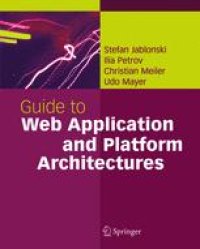
Ebook: Guide to Web Application and Platform Architectures
- Tags: Information Systems Applications (incl. Internet), Software Engineering, Computer System Implementation, Computing Milieux
- Year: 2004
- Publisher: Springer-Verlag Berlin Heidelberg
- Edition: 1
- Language: English
- pdf
New concepts and technologies are being introduced continuously for application development in the World-Wide Web. Selecting the right implementation strategies and tools when building a Web application has become a tedious task, requiring in-depth knowledge and significant experience from both software developers and software managers.
The mission of this book is to guide the reader through the opaque jungle of Web technologies. Based on their long industrial and academic experience, Stefan Jablonski and his coauthors provide a framework architecture for Web applications which helps choose the best strategy for a given project. The authors classify common technologies and standards like .NET, CORBA, J2EE, DCOM, WSDL and many more with respect to platform, architectural layer, and application package, and guide the reader through a three-phase development process consisting of preparation, design, and technology selection steps. The whole approach is exemplified using a real-world case: the architectural design of an order-entry management system.
New concepts and technologies are being introduced continuously for application development in the World-Wide Web. Selecting the right implementation strategies and tools when building a Web application has become a tedious task, requiring in-depth knowledge and significant experience from both software developers and software managers.
The mission of this book is to guide the reader through the opaque jungle of Web technologies. Based on their long industrial and academic experience, Stefan Jablonski and his coauthors provide a framework architecture for Web applications which helps choose the best strategy for a given project. The authors classify common technologies and standards like .NET, CORBA, J2EE, DCOM, WSDL and many more with respect to platform, architectural layer, and application package, and guide the reader through a three-phase development process consisting of preparation, design, and technology selection steps. The whole approach is exemplified using a real-world case: the architectural design of an order-entry management system.
New concepts and technologies are being introduced continuously for application development in the World-Wide Web. Selecting the right implementation strategies and tools when building a Web application has become a tedious task, requiring in-depth knowledge and significant experience from both software developers and software managers.
The mission of this book is to guide the reader through the opaque jungle of Web technologies. Based on their long industrial and academic experience, Stefan Jablonski and his coauthors provide a framework architecture for Web applications which helps choose the best strategy for a given project. The authors classify common technologies and standards like .NET, CORBA, J2EE, DCOM, WSDL and many more with respect to platform, architectural layer, and application package, and guide the reader through a three-phase development process consisting of preparation, design, and technology selection steps. The whole approach is exemplified using a real-world case: the architectural design of an order-entry management system.
Content:
Front Matter....Pages i-xi
Front Matter....Pages 1-1
Introduction....Pages 3-5
Framework Architecture....Pages 7-38
Developing WAA and WPA....Pages 39-61
Classification of Internet Standards and Technologies....Pages 63-74
Front Matter....Pages 75-75
Basic Programming Concepts for Web Applications....Pages 77-98
Component-Oriented Software Development....Pages 99-119
Web Services and Web Applications....Pages 121-147
Web Site Engineering and Web Content Management....Pages 149-168
Front Matter....Pages 169-169
Why Technologies and Standards Are Not Enough....Pages 171-176
Registries....Pages 177-189
Organizations and Organizational Structures....Pages 191-202
Process Technology....Pages 203-210
Repositories....Pages 211-220
Putting It All Together....Pages 221-230
Back Matter....Pages 231-245
New concepts and technologies are being introduced continuously for application development in the World-Wide Web. Selecting the right implementation strategies and tools when building a Web application has become a tedious task, requiring in-depth knowledge and significant experience from both software developers and software managers.
The mission of this book is to guide the reader through the opaque jungle of Web technologies. Based on their long industrial and academic experience, Stefan Jablonski and his coauthors provide a framework architecture for Web applications which helps choose the best strategy for a given project. The authors classify common technologies and standards like .NET, CORBA, J2EE, DCOM, WSDL and many more with respect to platform, architectural layer, and application package, and guide the reader through a three-phase development process consisting of preparation, design, and technology selection steps. The whole approach is exemplified using a real-world case: the architectural design of an order-entry management system.
Content:
Front Matter....Pages i-xi
Front Matter....Pages 1-1
Introduction....Pages 3-5
Framework Architecture....Pages 7-38
Developing WAA and WPA....Pages 39-61
Classification of Internet Standards and Technologies....Pages 63-74
Front Matter....Pages 75-75
Basic Programming Concepts for Web Applications....Pages 77-98
Component-Oriented Software Development....Pages 99-119
Web Services and Web Applications....Pages 121-147
Web Site Engineering and Web Content Management....Pages 149-168
Front Matter....Pages 169-169
Why Technologies and Standards Are Not Enough....Pages 171-176
Registries....Pages 177-189
Organizations and Organizational Structures....Pages 191-202
Process Technology....Pages 203-210
Repositories....Pages 211-220
Putting It All Together....Pages 221-230
Back Matter....Pages 231-245
....